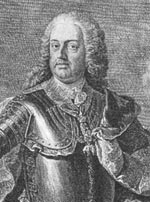Frans I (Franz 1. Stefan)

Samidigt kobberstik.
Østrigsk kejser 1745-65. Oprindeligt hertug Frans Stefan af Lorraine 1729-35, som i 1736 blev gift med Kejser Karl 6.s datter Maria Theresia og i 1745 blev valgt til tysk-romersk kejser under navnet Frans 1. Maria Theresia havde allerede ved sin faders død i 1740 overtaget regeringen over de østrigske arvelande.
Tysk-romersk kejser 1745-65. 1729-35 hertug af Lothringen, som han afstod til Frankrig mod at få Toscana 1737. Gift 1736 med Maria Thresia af Østrig, der gjorde ham til medregent 1740 og fik ham valgt til tysk kejser under Østrigske Arvefølgekrig, hvorved det habsburg-lothringske eller yngre habsburgske hus opstod. Gemalinden stod dog hovedsagelig for styret.
- Østrigske Arvefølgekrig, 1740-48
- Mollwitz, 1741
- Hohenfriedeberg, 1745
- Soor, 1745
- Hennersdorf, 1745
- Kesselsdorf, 1745
- Rocourt, 1746
- Maastricht III, 1748
Frans I Stefan (Frands, Frants, ty. Franz) (1708-65), tysk-romersk kejser. Fra 1729 hertug af Lothringen, hvilket land han 1735 ombyttede med Toscana (overtaget 1737). Levede fra 1736 i lykkeligt ægteskab med Maria Theresia og var fra 1740 hendes medregent, men uden stor indflydelse, en stilling, han ofte følte ydmygende. 1745 valgt til tysk kejser. Han var vel begavet, men tarvelig uddannet; hans hovedinteresser var lagt og videnskabelige dilettanterier; han var en dygtig finansmand. Politisk stod han Frankrig nær. (HK4/1922)
Francis I (December 8, 1708 — August 18, 1765) was Holy Roman Emperor and grand duke of Tuscany.
He was the second son of Leopold Joseph, duke of Lorraine, and his wife Elizabeth Charlotte, daughter of Philip, Duke of Orleans. He was connected with the Habsburgs through his grandmother Eleanore, daughter of Emperor Ferdinand III, and wife of Charles Leopold of Lorraine. Emperor Charles VI favoured the family, who, besides being his cousins, had served the house of Austria with distinction. He had designed to marry his daughter Maria Theresa to Francis's older brother Clement. On Clement's death Charles adopted the younger brother as his future son-in-law. Francis was brought up in Vienna with Maria Theresa on the understanding that they were to be married, and a real affection arose between them.
At the age of fifteen, when he was brought to Vienna, he was established in the Silesian duchy of Teschen, which had been mediatized and granted to his father by the emperor in 1722. He succeeded his father as duke of Lorraine in 1729, but the emperor, at the end of the War of the Polish Succession, desiring to compensate his candidate Stanislaus Leszczynski for the loss of his crown in 1735, persuaded Francis to exchange Lorraine for the grand duchy of Tuscany. On February 12, 1736 Francis and Maria Theresa were married, and they went for a short time to Florence, when he succeeded to the grand duchy on the death of John Gaston, the last of the ruling house of Medici. His wife secured his election to the Empire on the September 13, 1745, in succession to Charles VII, and she made him co-regent of her hereditary dominions. Francis was well content to leave the wielding of power to his able wife. He had a natural fund of good sense and some business capacity, and was a useful assistant to Maria Theresa in the laborious task of governing the complicated Austrian dominions, but his functions appear to have been primarily secretarial. He died suddenly in his carriage while returning from the opera at Innsbruck on August 18, 1765.
Maria Theresa and Francis I had sixteen children, the youngest daughter of whom was the future queen of France, Marie Antoinette.
Moder: Elizabeth Charlotte